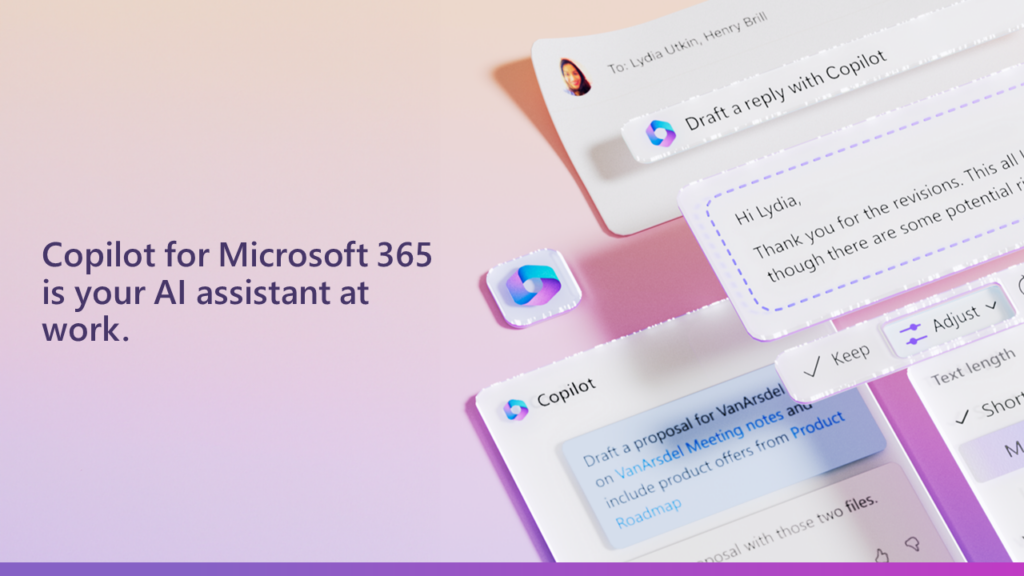Artificial intelligence (AI) is transforming the way we work, communicate, and create. AI tools can help us automate tasks, generate insights, and enhance our capabilities. One of the most powerful and innovative AI tools available today is Copilot for Microsoft 365, a generative AI assistant that can help you with various aspects of your work, from data analysis to content creation.
In this blog post, we will:
- Share some best practices and tips on how to use Copilot for Microsoft 365 to improve your productivity and creativity across different job roles and functions.
- Discuss the benefits and challenges of adopting an AI-first mentality, and how to overcome them with prompt engineering and plugins.
- Highlight some use cases of how Copilot can transform your workflow and efficiency.
The Mindset for Success with AI

The first step to using Copilot effectively is to have an AI-first mentality. This means that you are willing to explore, experiment, and trust AI to augment your workflow and productivity. You are not afraid to ask high-value questions, and to challenge the AI to provide high-value responses.
However, having an AI-first mentality also comes with some challenges. One of them is overcoming creative blocks, which can happen when you are not sure what to ask the AI, or when the AI does not understand your request. Another challenge is trusting the AI, which can be difficult when you are not familiar with how the AI works, or when the AI makes mistakes or provides inaccurate information.
To increase trust in the content returned by AI, read this blog post to ensure your organization is ready for Copilot for Microsoft 365, and this blog post to make sure you have proper data protection and access controls in place.
The Importance of Prompt Engineering
To overcome these challenges, you need to develop a skill called prompt engineering. Prompt engineering is the art of crafting concise, specific, and organized prompts that elicit the best responses from the AI. Prompt engineering involves reverse engineering the conversation to get to the desired goal and providing enough context and information for the AI to understand your request.
For example:
- If you want to use Copilot to create a marketing plan, you can start by asking a general question, such as “What are the steps to create a marketing plan?”.
- Then, you can refine your prompt by adding more details, such as “What are the steps to create a marketing plan for a new IT solution that targets small and medium businesses in the US?”.
- Finally, you can ask for specific outputs, such as “Please generate a bullet point list of the steps to create a marketing plan for a new IT solution that targets small and medium businesses in the US.”.
By using prompt engineering, you can improve the quality and relevance of the Copilot’s responses and learn more about how the AI thinks and works.
Want Help on Your Journey?
Our free two-hour Microsoft Copilot for M365 readiness briefing ensures your organization is prepared to take advantage of Copilot.
Summarize Data with Copilot for M365
One of the most valuable features of Copilot for M365 is its ability to summarize large amounts of data and extract key insights. Copilot can help you digest information from various sources, such as reports, articles, emails, surveys, or spreadsheets, and provide you with a concise and clear summary of the main points and takeaways.
This can be very useful for managers and executives who need to make informed decisions and communicate effectively with their teams and stakeholders. Copilot can help them save time, avoid information overload, and focus on the most important aspects of their work.
For example:
- Copilot can help a marketing manager to summarize the results of a customer satisfaction survey and provide recommendations on how to improve the customer experience.
- Copilot can also help a sales manager to summarize the performance of their sales team and provide feedback and tips on how to increase sales and revenue.
- Copilot can also help a finance manager to summarize the financial statements of their company and provide insights on how to optimize costs and profits.
Copilot can help with data summarization across different business functions, such as marketing, sales, HR, finance, operations, and IT. Copilot can also help with different types of data, such as numerical, textual, or visual by generating charts, graphs, and tables to visualize the data and make it easier to understand.
Plugins and Advanced Data Retrieval Add More Value
Another feature that makes Copilot for M365 powerful and versatile is its ability to access and retrieve data from various sources, using plugins and connectors. Plugins are extensions that enhance Copilot’s capabilities by letting it interact with third-party systems, such as CRM, ERP, or cloud services. Connectors are integrations that enable Copilot to access data from line of business systems, such as SharePoint, OneDrive, or Teams.
By using plugins and connectors, Copilot for M365 can become more contextually aware and responsive to your needs. Copilot can also provide more accurate and relevant information, as it can access the most up-to-date and reliable data sources.
For example:
- Copilot can use a plugin to access Salesforce, and provide you with information on your leads, opportunities, and accounts.
- Copilot can also use a connector to access SharePoint, and provide you with information on your projects, documents, and tasks.
- Copilot can also use a plugin to access Bing, and provide you with information on the web, such as news, images, or videos.
By using plugins and connectors, Copilot can enable more integration and collaboration across your organization and improve your decision making and solution design.
Read more on how Copilot can transform your organization.
Common Use Cases for Copilot for M365
Copilot for M365 can help you with various tasks and scenarios that are time-intensive, tedious, or challenging. Tasks and scenarios that require creativity, innovation, or inspiration become easier. The value of Copilot increases as your responsibilities and data sources expand because of its ability to quickly summarize large amounts of data.
Here are some examples of how Copilot can help you with different use cases:
- Content creation: Copilot can help you create content for various purposes, such as blog posts, newsletters, social media posts, presentations, or proposals. Copilot can help you generate ideas, headlines, outlines, and content. Copilot can also help you edit, rewrite, improve, or optimize your content.
- Data analysis: Copilot can help you analyze data for various purposes, such as reports, dashboards, forecasts, or models. Copilot can help you summarize, visualize, and interpret data. Copilot can also help you find patterns, trends, correlations, or anomalies in data.
- Problem solving: Copilot can help you solve problems for various purposes, such as troubleshooting, debugging, or optimization. Copilot can help you identify, diagnose, and resolve problems. Copilot can also help you find solutions, alternatives, or improvements for problems.
- Learning and development: Copilot can help you learn and develop for various purposes, such as education, training, or certification. Copilot can help you find, access, and consume learning resources. Copilot can also help you test, assess, and improve your knowledge and skills.
Ready to Deploy Copilot for Microsoft 365?
Contact us to see how we can help you move forward quickly.
Conclusion
Copilot for Microsoft 365 is a powerful and innovative AI tool that can help you boost your productivity and creativity across different job roles and functions. Overcoming creative blocks, generating content, and summarizing data becomes a breeze as Copilot helps you access and retrieve data from various sources, using plugins and connectors.
To use Copilot effectively, you need to have an AI-first mentality, where you are willing to explore, experiment, and trust AI to augment your workflow and productivity. You also need to develop your prompt engineering skills, where you craft concise, specific, and organized prompts that elicit the best responses from AI.




